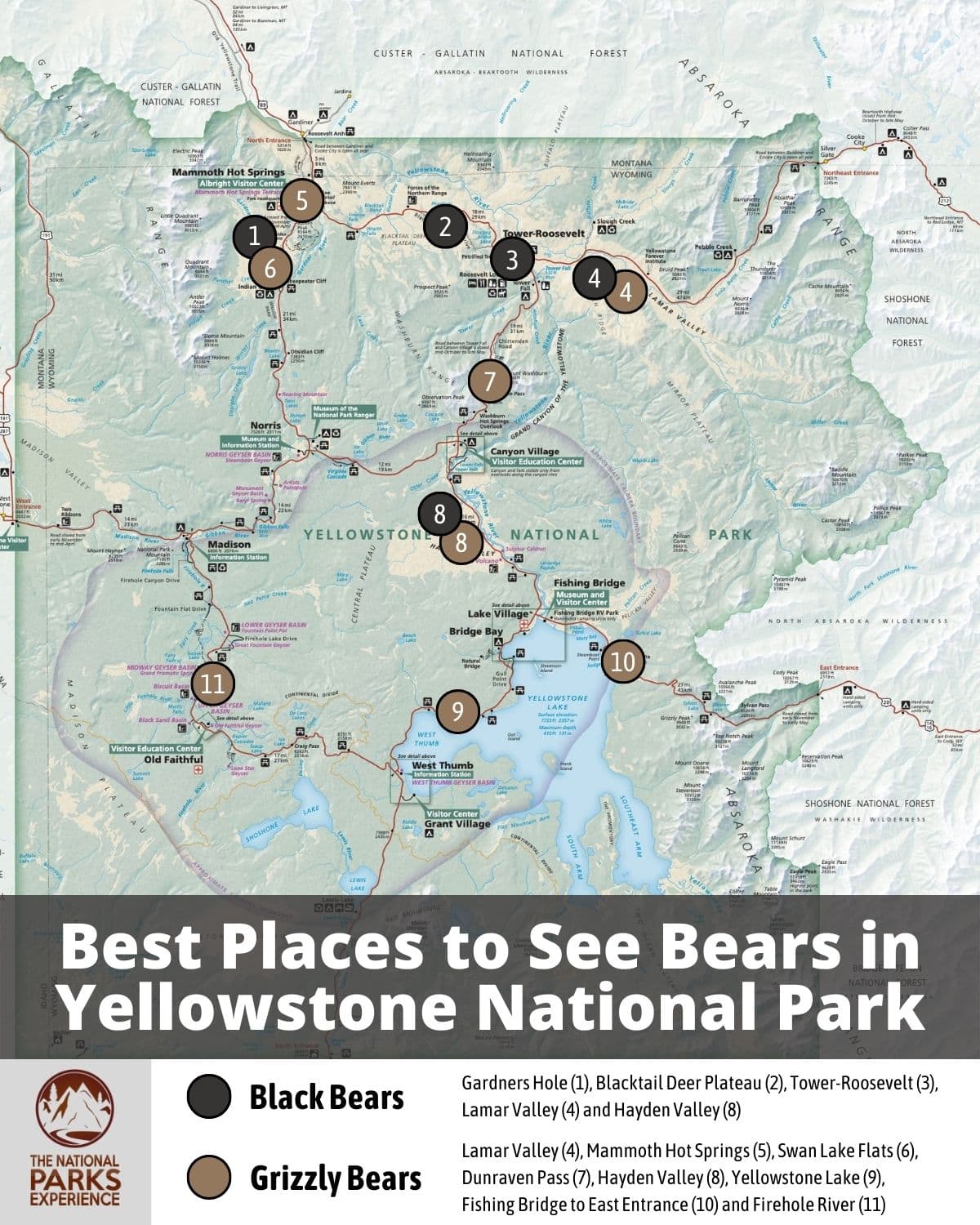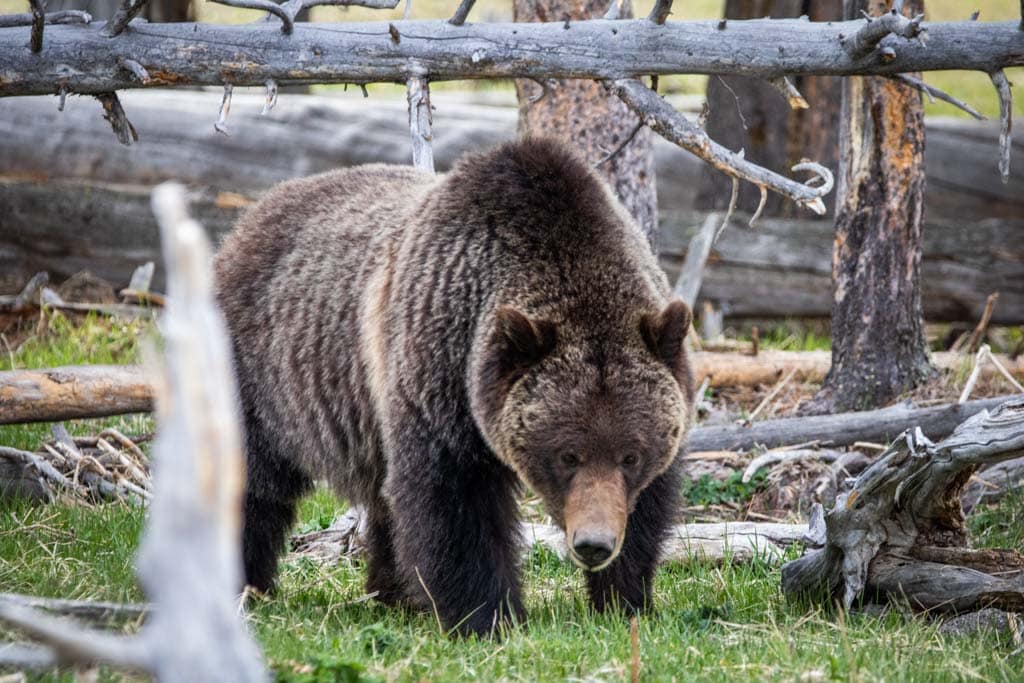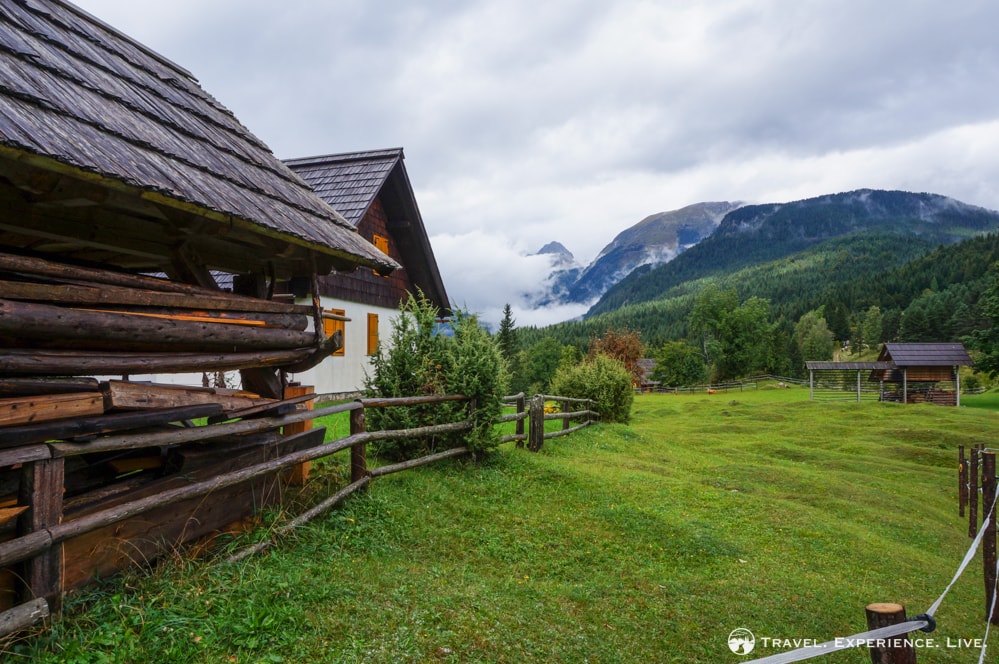Where to See Bears in Yellowstone National Park
Yellowstone National Park is one of only a few national parks in the contiguous United States that are home to two species of bears: black bears (Ursus americanus) and grizzly bears (Ursus arctos horribilis).
Although both species are present all throughout the park, some areas are superior to others when it comes to seeing bears in the wild in Yellowstone National Park.
Below, you’ll find the best places to see both black bears and grizzly bears in Yellowstone.
This blog post about the best places to see bears in Yellowstone National Park contains affiliate links. You can read more about our Terms of Use / Disclosure here.
What Are the Differences Between Black Bears and Grizzly Bears?
When watching bears in Yellowstone, you’d probably want to know which bear you’re looking at!
While there are a number of significant differences between black bears and grizzlies, it can sometimes be challenging to figure out what species it is from a distance.
So, hopefully, the following information will help you determine whether you’re observing a black or grizzly bear in Yellowstone.
How to Recognize Black Bears
The American black bear lives all over the United States and Canada.
It is the smallest of the three bear species found in North America—the polar bear is the third North American bear and by far the largest. Extremely adaptable, black bears are present all over the country, in at least 40 states.
You can recognize a black bear by its straight face profile, small claws, large protruding ears and lack of shoulder hump.
Although they’re called “black”, black bears can actually be black, but also dark brown, brown, blue-ish black and cinnamon. Because of this, they’re occasionally confused for grizzlies.
Even if the animal is a lighter brown color, its long ears and the absence of a shoulder hump should confirm it’s a black bear.
Black bears are very common in Yellowstone National Park.
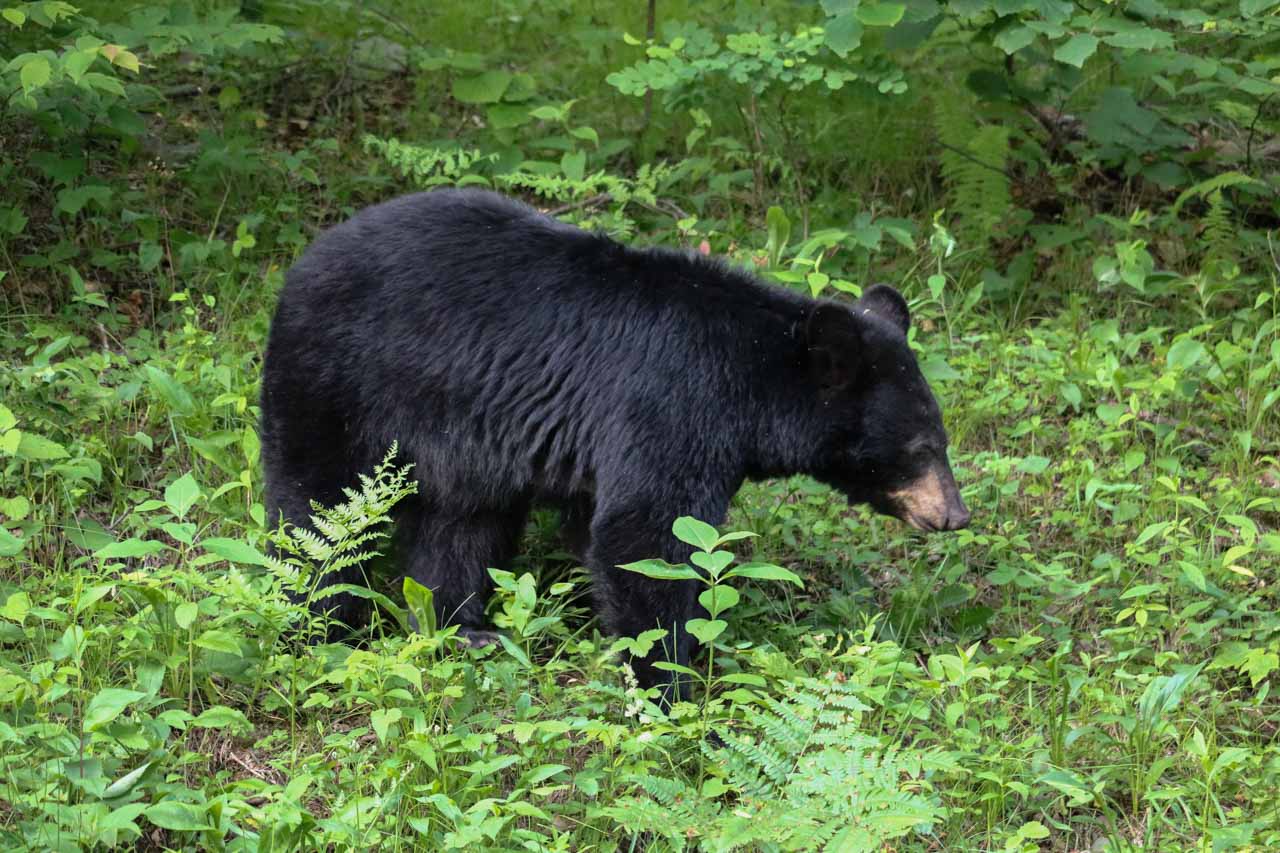
Fun Facts About Yellowstone’s Black Bears
- American black bears are the only bear species endemic to North America. They aren’t found in the wild on other continents.
- Black bears can climb trees very well.
- Their preferred habitats include dense forests and woodland edges.
- Black bears are omnivores. Their diet consists of various foods, from elk calves, rodents, cutthroat trout and insects to grasses, pine nuts, fruit, berries and other plant materials.
- Male black bears weigh 210-315 pounds, while female black bears weigh 135-200 pounds.
- Adult black bears are about 3 feet high at the shoulder.
- Black bears can grow 15-30 years old.
- Black bears have a superb sense of smell and can see colors.
- Female black bears don’t tend to attack humans to protect their cubs. Their instinctive reflex is usually to run away or climb a tree.
- Black bear attacks are extremely rare (when they do occur, they’re often predatory).
- There has never been a confirmed fatal black bear attack in Yellowstone National Park.
How to Recognize Grizzly Bears
A subspecies of the brown bear, grizzly bears are some of the most-feared animals in America. This is, of course, unjustified.
Yes, they may be huge and imposing, powerful enough to cause major injuries to any other animal, including humans, but they can also be gentle and curious.
Grizzly bears are, on average, much larger than black bears. According to the National Park Service, they’re “generally 1.5 to 2 times larger than black bears of the same sex and age class within the same geographic region.”
The most distinctive body features of grizzlies are their large claws and clearly visible shoulder hump. Both these characteristics help grizzlies dig for food.
Additionally, grizzly bears have short, rounded ears and a so-called “dished” face profile, with a nose that somewhat sticks out from their face.
While they used to live all over North America, their range is now limited to Alaska, Canada and a few of the lower 48 states.
There are merely 1,500 grizzlies left in the lower 48 states, 800 of which live in northwest Montana, especially in the Glacier National Park area.
Another 700 or so call Wyoming’s Yellowstone-Grand Teton area home, two of the best national parks for wildlife watching, while Idaho has about 100 grizzly bears.
There are currently approximately 150 grizzly bears in Yellowstone National Park. Some of them have home range that is entirely within the park, while others roam in and out of the park.
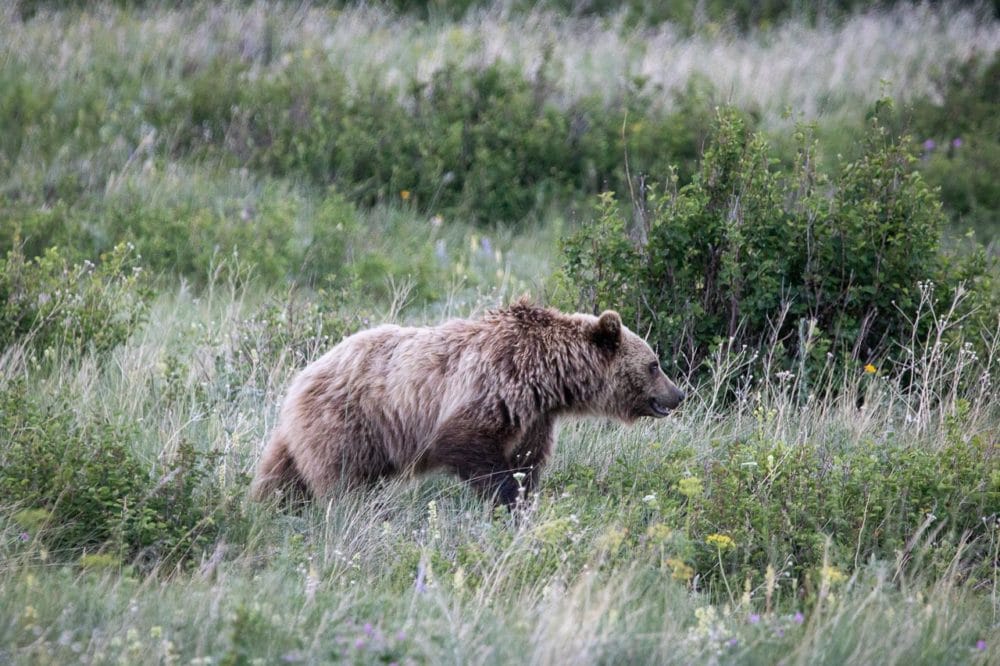
Fun Facts About Yellowstone’s Grizzly Bears
- Grizzlies are a subspecies of the brown bear. Grizzly bears are brown bears that don’t have access to food sources from the ocean. In coastal Alaska, Europe and Asia, they are known simply as brown bears.
- Young grizzly bears are able to climb trees. However, their weight and curved claws make this increasingly difficult as they get older.
- Grizzlies live in forests and are usually seen in and near meadows and clearings in the woods. In summer, they also move up to the park’s barren slopes and mountains.
- Grizzly bears are omnivores. They eat a wide variety of things, including the calves of elk, deer and bison, cutthroat trout, other (smaller) adult mammals, insects, carrion, roots, nuts, berries, grasses and other vegetation.
- Male grizzlies weigh 200-700 pounds, while female grizzlies weigh 200-400 pounds.
- Grizzly bears are about 3.5 feet high at the shoulder.
- Grizzly bears can grow 15-30 years old.
- Grizzlies are exceptionally agile and can sprint up to 40 mph, which is faster than a regular horse.
- Female grizzlies are notorious for aggressively defending their young against threats. The majority of grizzly attacks are defensive attack by sows with cubs.
- Grizzly bear attacks are very uncommon (when they do occur, they’re often defensive to protect cubs or a food source).
- Since Yellowstone National Park’s establishment in 1872, only 8 people have been killed by bears in the park. Seven of those fatalities were caused by grizzlies, while one was unconfirmed. This is out of an all-time visitation total of more than 195 million recreational visits (up to and including 2021).
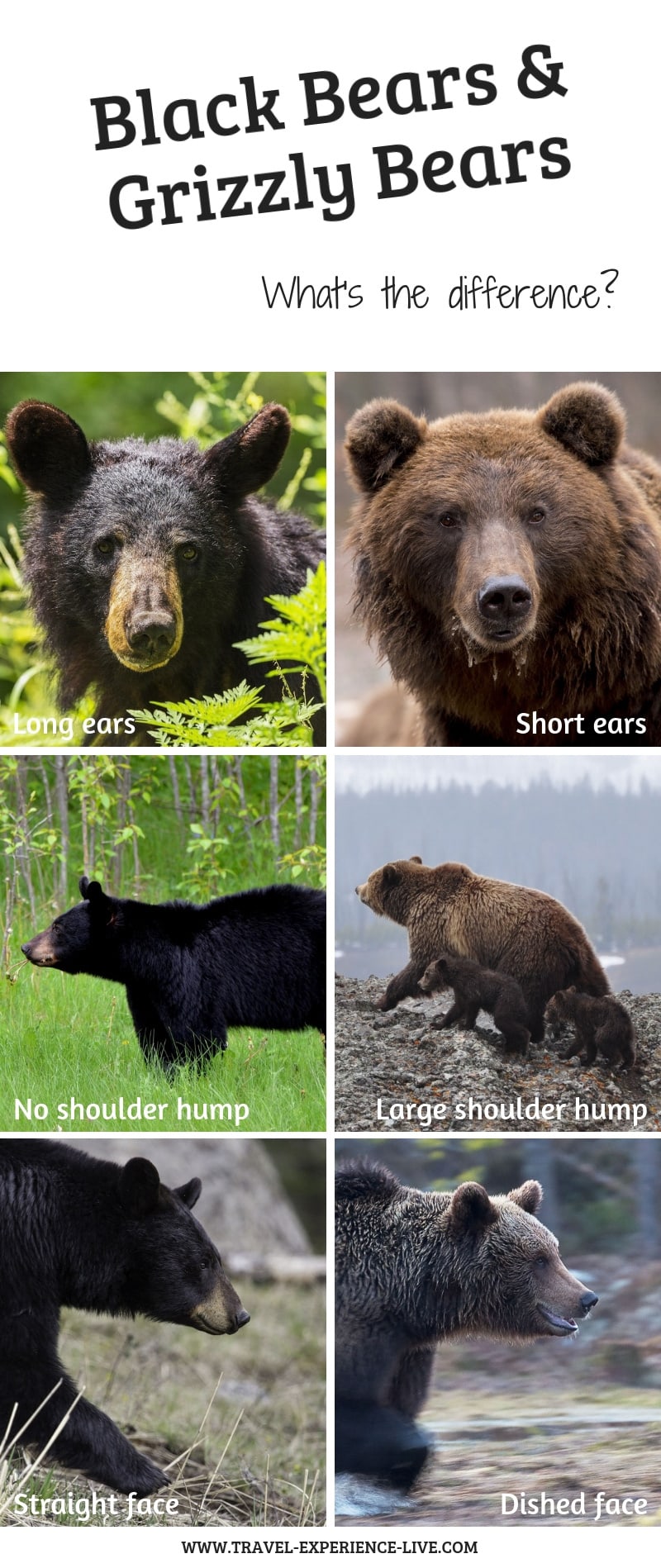
Best Places to See Bears in Yellowstone National Park
Although present across the park, the bears of Yellowstone seem to prefer certain areas over others. Where you’re most likely to see a bear depends (in some cases) on the species.
As mentioned above, black bears tend to seek out more forested areas, while grizzlies usually roam meadows, forest clearings and barren slopes.
These are generalizations, though. It’s possible to see either one of them anywhere in the park. That said, let’s check out where you can see black bears and grizzly bears in Yellowstone National Park
Where to See Black Bears in Yellowstone
Yellowstone National Park’s black bears are most commonly seen in the park’s Northern Range. You can find them from Mammoth east across Blacktail Deer Plateau, at Tower-Roosevelt, and in Lamar and Hayden valleys.
Gardners Hole
Black bears love the alternating forest and meadow areas south of Mammoth Hot Springs.
Especially the landscape between Mammoth and Indian Creek consists of excellent black bear habitat, home to woodlands, open meadows, ponds and gently sloping hills. You might need binoculars to see them here, though.
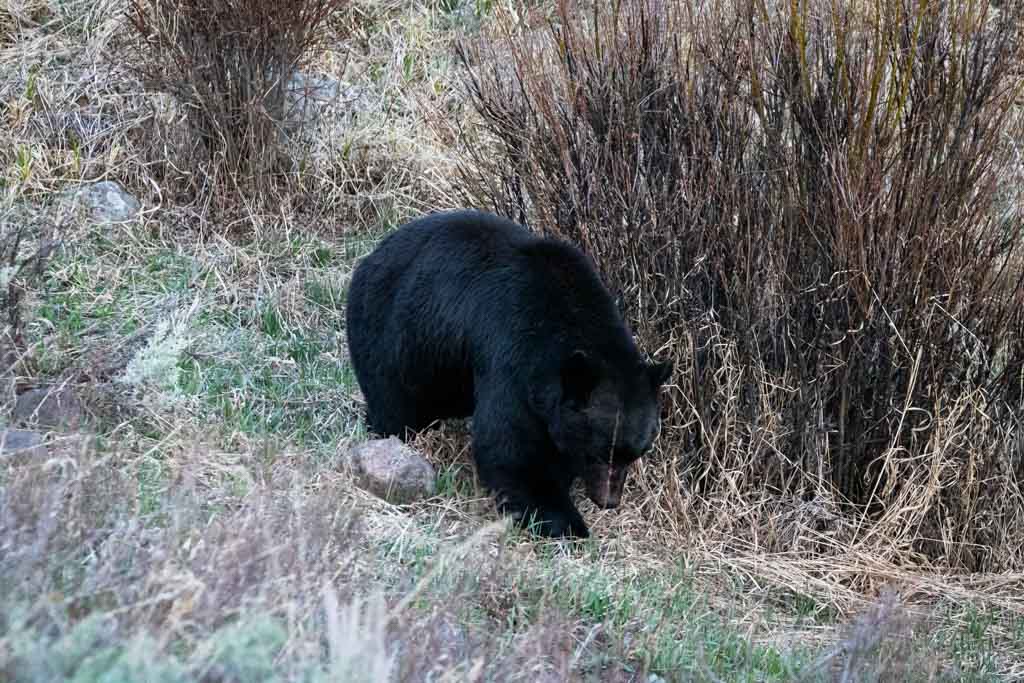
Blacktail Deer Plateau
A spectacular region between Mammoth and Tower-Roosevelt, Blacktail Deer Plateau is one of the most underrated places for wildlife viewing in Yellowstone.
Drive the (seasonally open) Blacktail Plateau Drive for the best chances to see black bears in this area. Additionally, lucky visitors might also spot one from the main road, particularly in the eastern portion of Blacktail Deer Plateau.
Tower-Roosevelt
Famous for being arguably the best place to see black bears in Yellowstone National Park, Tower-Roosevelt has thick forests, barren slopes, rock-strewn hills, meadows and ponds.
It’s the absolute ideal habitat for black bears, which are a very common sight here, even among the area’s buildings and facilities.
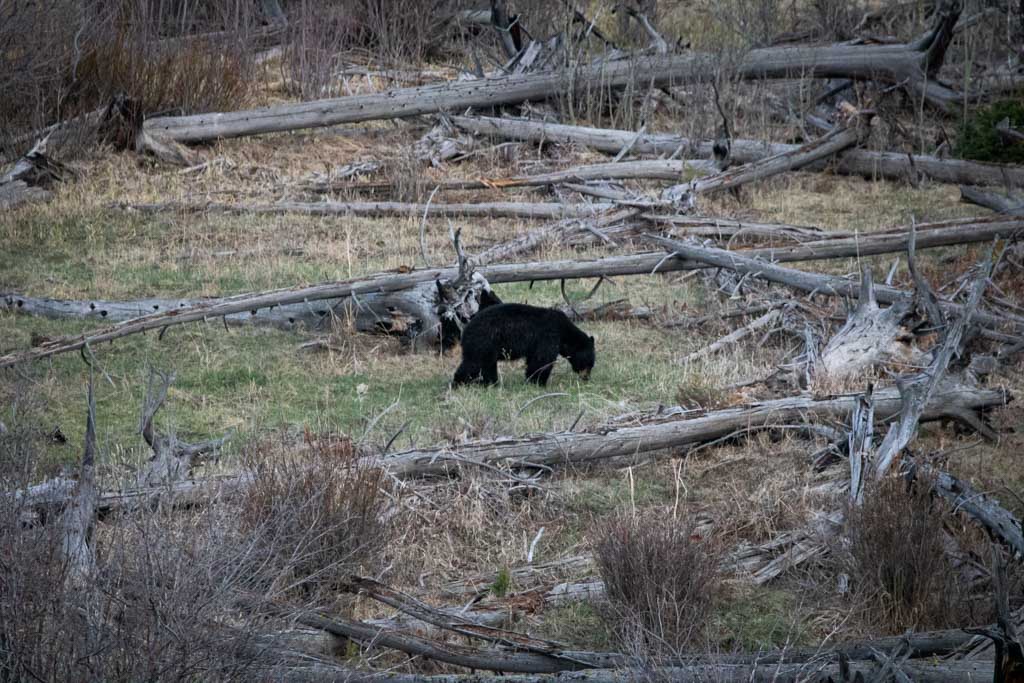
Lamar Valley
World-famous for its massive herds of bison and elk, Lamar Valley also supports numerous other animals. From pronghorn and bighorn sheep to wolves, grizzlies and black bears, it’s one of the greatest wildlife watching regions on the planet.
Visit early in the morning or late in the evening for the most optimal chances of seeing a black bear in Lamar Valley.
Hayden Valley
Although not as common in Hayden Valley as in Lamar Valley, black bears are occasionally seen here.
While driving between Canyon and Yellowstone Lake, it’s definitely worth stopping at the many roadside overlooks and scanning the tree line for moving black dots.
And if you don’t see a black bear in Hayden Valley, chances are pretty good you’ll spot some other iconic animals here. Watch for bison, elk, moose, grizzlies and even wolves.
Where to See Grizzly Bears in Yellowstone
Yellowstone is one of the few places remaining in the contiguous United States that have a large grizzly bear population.
These imposing animals roam the entire park, but the best chances of seeing a grizzly in Yellowstone are in the park’s expansive meadows, sagebrush-covered slopes and river valleys.
This includes Mammoth, Lamar and Hayden valleys, the shores of Yellowstone Lake, Swan Lake Flats and the meadows along the Firehole River.
Mammoth Hot Springs
Although they rarely venture into built-up part of Mammoth Hot Springs, grizzlies do like the surrounding area.
They can occasionally be seen meandering across the open areas north of Mammoth towards Gardiner. When driving east out of Mammoth, look for them on the sagebrush-covered slopes along the road.
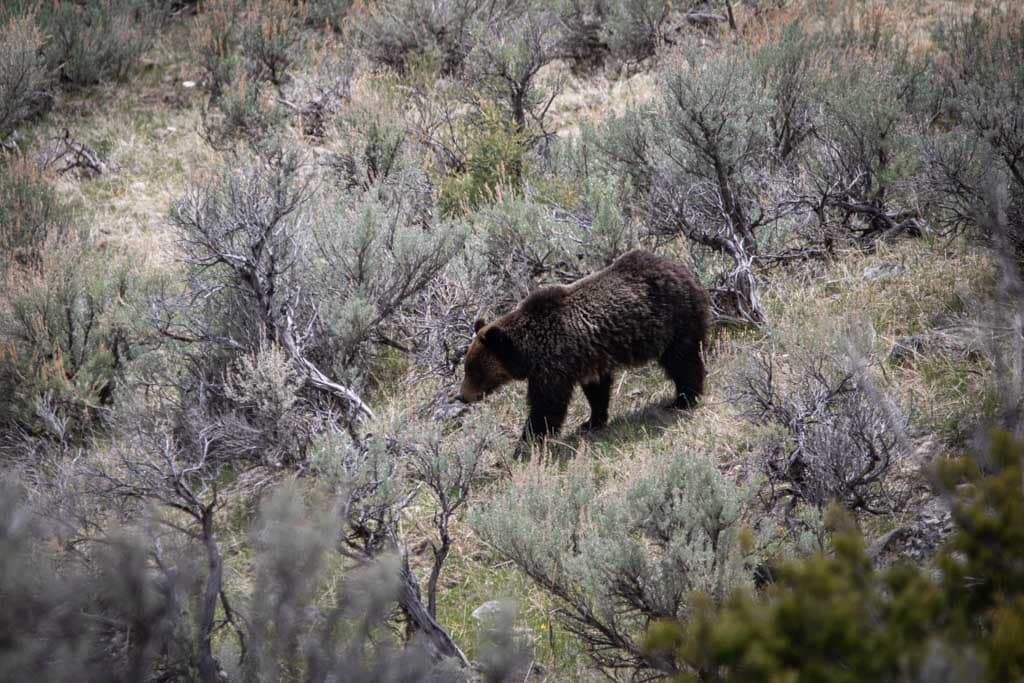
Swan Lake Flats
Located in the heart of Gardners Hole, a beautiful area just south of Mammoth that’s also preferred by black bears, Swan Lake Flats is prime grizzly habitat. Visit early in the morning or right before sunset to see one or more wandering across the meadows around Swan Lake.
As its name suggests, this is also a great place for bird watching, including iconic birds like trumpeter swans and sandhill cranes.
Lamar Valley
A sprawling valley between Tower-Roosevelt and the Northeast Entrance, Lamar Valley is home to huge numbers of bison and elk, which attract predators like wolves and bears.
In addition to live prey animals, this iconic valley also offers myriad other food sources to grizzly bears, from roots and grasses to insects and carcasses.
Grizzlies may be seen all over Lamar Valley, including its open meadows, riverbanks and slopes, and near forest edges.
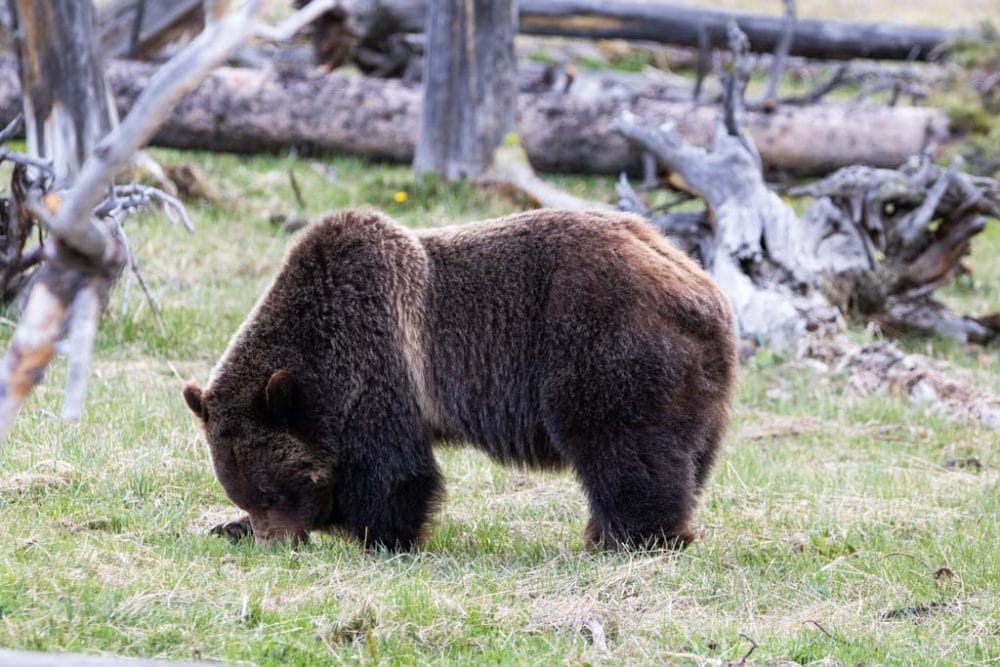
Dunraven Pass
In mid-summer, Dunraven Pass is usually crawling with grizzlies. This high-elevation area between Tower-Roosevelt and Canyon attracts grizzly bears with its whitebark pine nuts, which are favored food among these large, energy-burning bears.
Hayden Valley
Along with Lamar Valley, Hayden Valley is one of the most famous places to see animals in Yellowstone. This includes, of course, grizzly bears.
Hayden Valley is truly a phenomenal grizzly bear viewing area, mainly thanks to its commanding overlooks and wide open landscapes. There’s even a spot called Grizzly Overlook near the northern end of Hayden Valley!
Also keep an eye out for Yellowstone wolves, bison, moose and elk in this gorgeous valley bisected by the Yellowstone River. The occasional black bear may be spotted here as well.
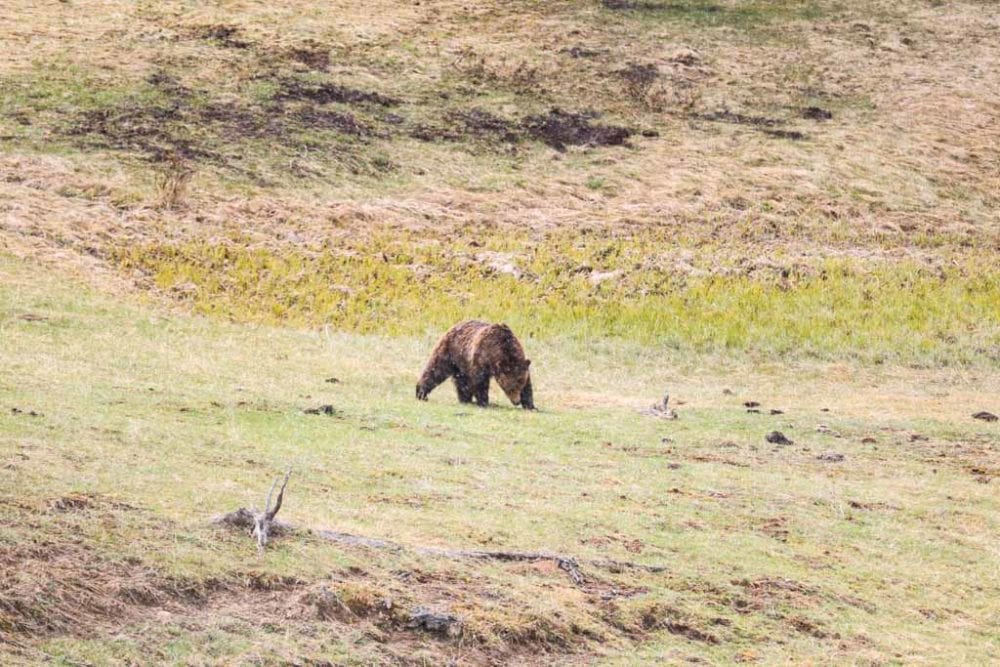
Yellowstone Lake
One of the best places to see grizzly bears in the southern portion of Yellowstone National Park is Yellowstone Lake.
You can sometimes see grizzlies fishing for trout in the streams that flow into the lake along the north shore. The West Thumb area is also a good place to potentially see a grizzly.
Fishing Bridge to East Entrance
The road from Fishing Bridge to the East Entrance is well-known for its grizzly sightings.
This scenic drive includes a section of the north shore of Yellowstone Lake. Especially Fishing Bridge itself, Mary Bay and Sedge Bay are great locations to look for grizzlies.
East of Yellowstone Lake, look for them in the wet meadows along the road, particularly near Sylvan Lake and Eleanor Lake. Sylvan Pass, on the other hand, provides lots of food sources after the year’s snowmelt.
Firehole River
Not often included in overviews of the best places to see grizzlies in Yellowstone National Park, the Firehole River is still an excellent area to find them.
Based on my own experience—I saw grizzlies in the Firehole Valley on three separate occasions during two days—I simply have to recommend spending some time here.
Running past several of Yellowstone’s renowned hydrothermal areas, including Old Faithful and Geyser Hill, the Midway Geyser Basin and the Lower Geyser Basin, the Firehole River is popular among bison and elk.
In the harsh Yellowstone winter, this area’s relative warmth attracts these large ungulates, which provide an easy food source to grizzly bears once they awake from hibernation. As such, grizzlies are commonly seen here from mid-spring through early-summer.
You can also spot them digging for roots in the meadows along the river.
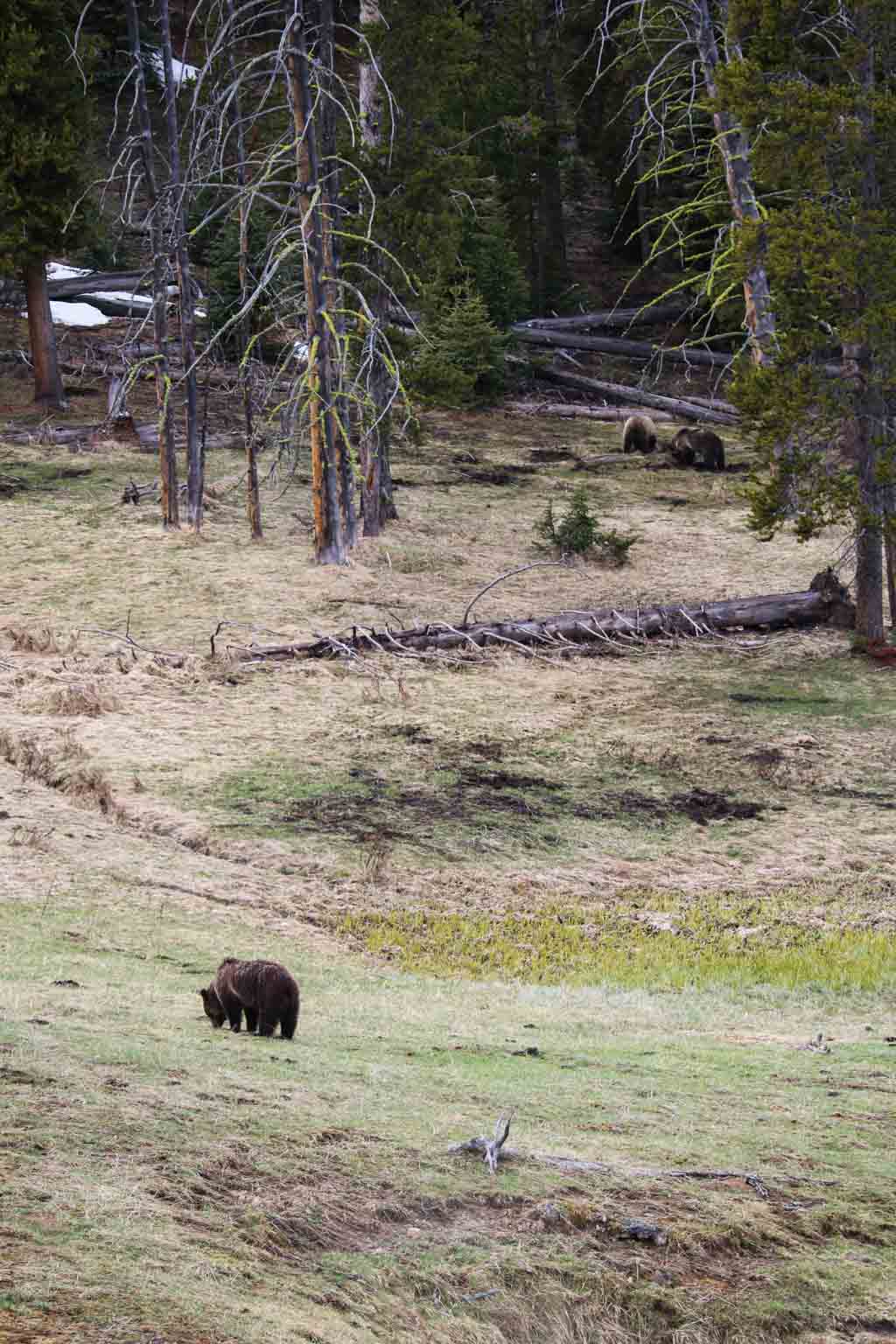
Bear Safety in Yellowstone National Park
Black Bears
As mentioned above, there has never been a confirmed fatality resulting from a black bear attack in Yellowstone National Park. However, as extremely rare as attacks by black bears are, they do occasionally occur.
The National Park Service says that Yellowstone black bears have caused “approximately one injury every five years since 1980.”
It’s still important to pay attention when recreating in Yellowstone National Park, though. Black bears are common throughout the park and you may encounter one anywhere.
LEARN WHAT TO DO WHEN ENCOUNTERING A BLACK BEAR HERE.
Grizzly Bears
Grizzly bears in Yellowstone are a different story. Essentially all deaths by bears in Yellowstone National Park were caused by grizzlies. However, the chance of being injured, let alone killed, by a grizzly is still very, very small.
According to the National Park Service, since 1980, “there have been 34 human injuries caused by grizzly bears in the backcountry, an average of one per year.”
In that same timespan, there have been only two grizzly-caused injuries to humans in developed areas. That’s just one every 20 years.
Risk of Grizzly Attacks in Yellowstone National Park, by Location
- Developed areas, roadsides and boardwalks: 1 in 59.5 million visits
- Frontcountry campgrounds: 1 in 26.6 million overnight stays
- Backcountry campgrounds: 1 in 1.7 million overnight stays
- Backcountry trails: 1 in 232,613 person travel days
- All park activities combined: 1 in 2.7 million visits
These numbers clearly show how unlikely it is to be attacked by a grizzly in Yellowstone.
Yet, it’s still extremely important to be vigilant when visiting Yellowstone National Park, especially when recreating in the backcountry or at dawn/dusk.
LEARN WHAT TO DO WHEN ENCOUNTERING A GRIZZLY BEAR HERE.
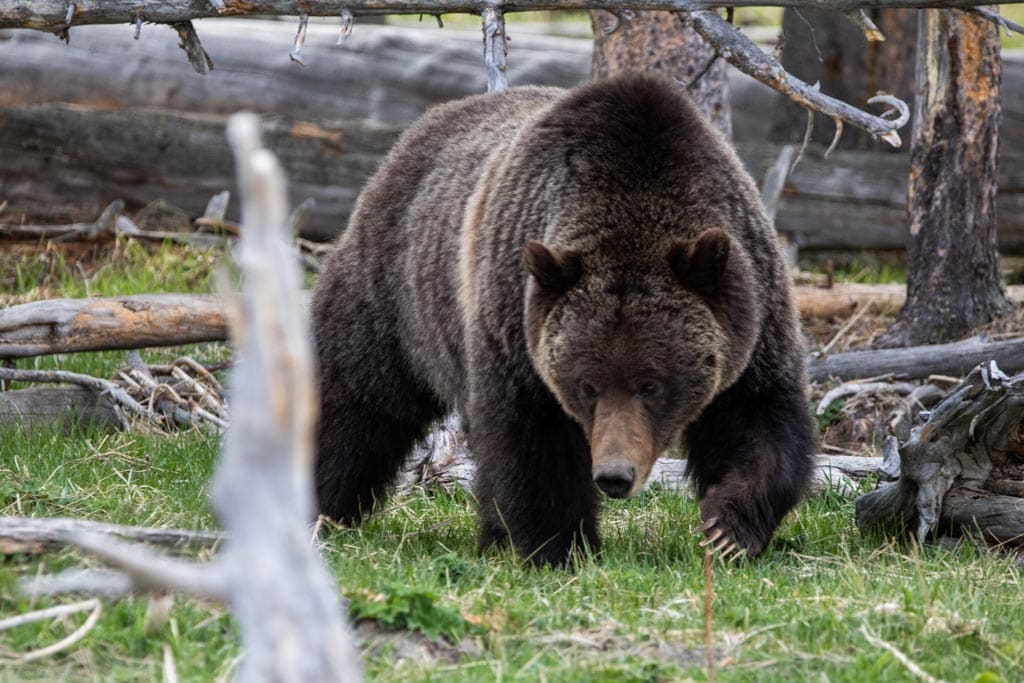
Bear Spray
By far the most effective way to protect yourself during a bear encounter, whether it’s a black bear or grizzly bear, is bear spray.
LEARN HOW TO USE BEAR SPRAY CORRECTLY HERE.
Recommended Books About Yellowstone National Park
- Yellowstone and Grand Teton National Parks (Full-Color Travel Guide) – Fodor’s Compass Guides
- Hiking Yellowstone National Park: A Guide To More Than 100 Great Hikes – Falcon Guides
- Empire of Shadows: The Epic Story of Yellowstone – George Black
- Deep Into Yellowstone: A Year’s Immersion in Grandeur & Controversy – Rick Lamplugh
- Yellowstone Ranger: Stories from a Life in Yellowstone – Jerry Mernin
- Decade of the Wolf: Returning the Wild to Yellowstone – Douglas Smith & Gary Ferguson
- The Reign of Wolf 21: The Saga of Yellowstone’s Legendary Druid Pack – Rick McIntyre
- Wild Rescues: A Paramedic’s Extreme Adventures in Yosemite, Yellowstone and Grand Teton – Kevin Grange
- Bring Jade Home: The True Story of a Dog Lost in Yellowstone and the People Who Searched for Her – Michelle Caffrey
- Taken by Bear in Yellowstone: More Than a Century of Harrowing Encounters between Grizzlies and Humans – Kathleen Snow
- Death in Yellowstone: Accidents and Foolhardiness in the First National Park – Lee H. Whittlesey
Map of the Best Places to See Bears in Yellowstone National Park
